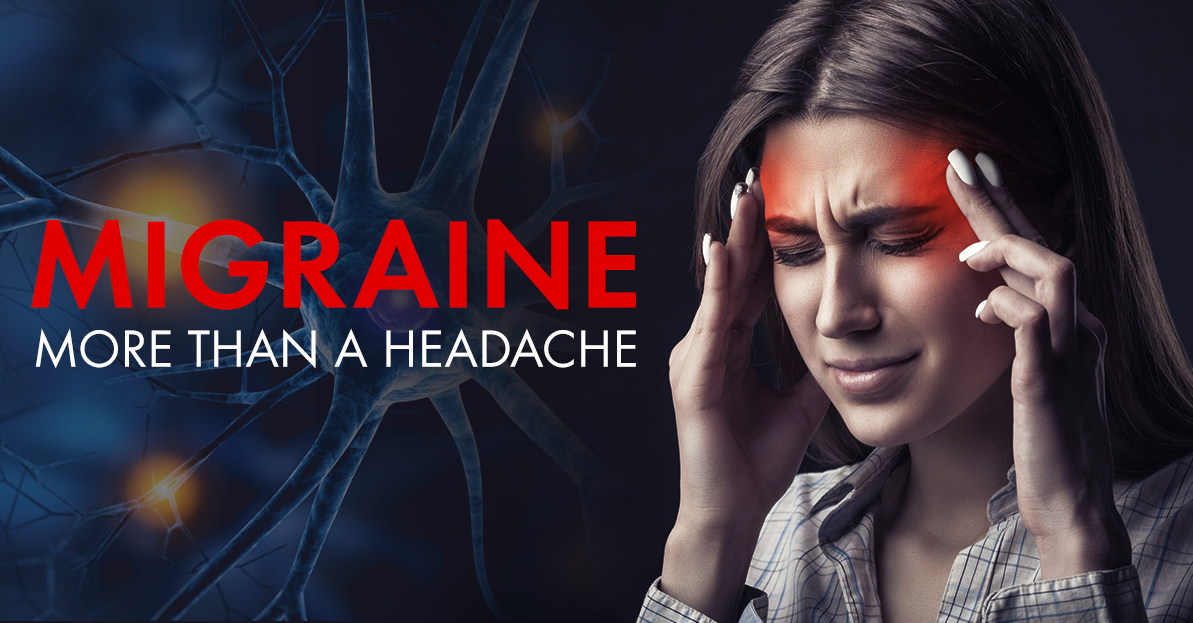Migraine, a word so brief, yet behind it lies a world of pain, misunderstood by many but intimately familiar to those who endure its grasp. Imagine a pain so crippling that it halts the flow of life around you; this is the actual reality for those who navigate through the turbulent waters of migraines. The journey into understanding this health issue, is akin to exploring a labyrinth, where every turn reveals new insights and every corridor holds echoes of pain and hope.
Migraine , the second most common cause of headache, and the most common headache related, cause of disability in the world. We should remember that the migraine is just beyond a normal headache, it is usually an episodic headache associated with certain features such as sensitivity to light, sound or even movement, nausea and vomiting often accompany the headache. A migraine attack has usually three phases: prodrome, headache phase, and postdrome, each with different disabling symptoms. Some percentage of patients have a fourth phase as well, known as the ‘aura’ phase. Migraine is well recognized by its stimulating factors, whom we call as ‘triggers’. The headache is initiated or amplified by various trigger factors like glare, bright lights, sounds, movements or even hunger, stress, physical exertion, atmospheric changes (like pressure changes) , hormonal fluctuations, lack of sleep, alcohol etc. It’s of utmost importance for a patient to have the knowledge of the trigger factors, and hence can be useful in management strategies.
Delving into the heart of migraine’s mystery requires us to navigate the intricate pathways of pathogenesis, where the intersection of biology, environment, and genetics paints a vivid picture of this debilitating condition. The journey of understanding migraines takes us deep into the cellular landscapes and neural circuits, where the dance of ions, neurotransmitters, and inflammatory molecules choreographs the pain and symptoms experienced by millions.
The sensory sensitivity which is characteristic of migraine is probably due to dysfunction of monoaminergic sensory control systems, activation of cells in Trigeminal nucleus results in the release of Vasoactive neuropeptides, particularly calcitonin gene-related peptide (CGRP).
CGRP emerges as a pivotal player in the migraine saga, a molecular messenger that carries the tales of pain and inflammation within the brain’s intricate networks. This neuropeptide, flourishing within the central and peripheral nervous system, acts as a double-edged sword: essential for normal neurological function yet capable of triggering the cascade of events leading to the intense, debilitating pain characteristic of migraines. Other brainstem regions likely to be involved in descending modulation and of Trigeminal pain include the nucleus locus coeruleus in the pons and rostral ventromedial medulla. Different pharmacological modalities have been developed around the given scenario and hence improving the chances to treat the disabling condition in the best possible way.
Involvement of Dopamine in the pathophysiology of migraines, though less directly visible compared to other mechanisms, is increasingly recognized as significant. Most migraine symptoms can be induced by dopaminergic stimulation, along with this, there is Dopamine receptor hypersensitivity in migraine patients, as seen by the induction of yawning, nausea, vomiting, hypotension, that’s why Pharmacological treatment targeting dopamine receptors are effective therapeutic agents in migraine.
The genetic involvement in migraines underscores the condition’s complexity and variability, pointing to a hereditary predisposition that can influence an individual’s susceptibility to migraine attacks. Research has illuminated the significant role that genetics play in the development and manifestation of migraines. Mutations involving the P/Q- type voltage gated Calcium Channel CACNA1A gene are now known to cause Familial Hemiplegic migraine (FHM). Other mutations causing FHM include ATP1A2 gene, SCN1A gene.
When exploring the clinical features of migraines, one enters a realm where pain transcends its usual boundaries, morphing into a multifaceted experience that can significantly impair an individual’s quality of life. Migraines are not merely headaches; they are complex neurological events characterized by a constellation of symptoms that can vary widely among sufferers. It’s really important to have the knowledge about the most common and most important symptoms of migraine, so that we will not consider a probable migraine as just a normal headache, which further delays the treatment eventually leading to worsening the problem.
In the core of a migraine episode lies the hallmark symptom: a pulsating, throbbing pain typically localized to one side of the head. The migraine Aura, consisting of visual disturbances with flashing lights or zigzag lines moving across the visual fields. The headache is often associated with features like, Nausea (in 87% patients), photophobia (82% patients) , Lightheadedness( 72% patients affected), Vomiting (65%), and other features like scalp tenderness, vertigo etc.
Migraine with Aura is called ‘Classical Migraine’, while without aura is known as ‘Common Migraine’.
A simple criterion to diagnose migraine includes:
Repeated attacks of headache lasting 4-72 hours in patients with a normal physical examination, no other cause for headache and- at least 2 of the following features : Unilateral Pain, Throbbing pain, Aggravation by movement, Moderate or Severe intensity. Plus at least 1 of the following features: Nausea/Vomiting, Photophobia and Phonophobia.
Strongest predictors of Migraine diagnosis
Photophobia (Light aggravating the headache), Impairment (headache limiting or affecting daily activities), Nausea (Feeling of Vomiting when having a headache).
The treatment of migraines represents a beacon of hope for millions who navigate the stormy seas of this debilitating condition. With advancements in medical science and a deeper understanding of the neurological underpinnings of migraines, a spectrum of therapeutic strategies has emerged, offering relief and a path towards improved quality of life for sufferers.
First and foremost treatments include Lifestyle Modifications like Good Sleep, Exercise, Proper Eating, Stress Management, offering a proactive approach to reducing the frequency and severity of attacks. Pharmacological treatment for acute attacks of migraine include NSAIDs: Ibuprofen, Naproxen, Paracetamol along with caffeine, can reduce the severity and duration of migraine attack significantly. Even many undiagnosed cases self treat with NSAIDs. A general consensus is that NSAIDs are most effective when taken early in the attack.
Other medications include 5HT 1B/1D receptor agonists : Sumitriptan, almotriptan, Eletriptan, zolmitriptan etc. Ergotamine and Dihydroergotamine are other useful medications for acute attacks. Antiemetics (for Nausea/Vomiting) – include Metoclopramide, Prochlorperazine etc. Other useful groups of medications include CGRP Receptor Agonists known as Gepants – like Ubrogepant, Remigepant.
Besides acute attacks, the medications which help to prevent the further attacks of migraine include- Valproate, Propranolol, Metoprolol, TCAs (Amitriptyline) , moderate efficacy drugs include Candesartan, Lisinopril, Memantine, Venlafaxine, Serotonergics (Pizotifen), Neuromodulation, CBT(Cognitive behavioral therapy), Acupuncture, Biofeedback relaxing training. Newer modalities include Monoclonal Antibodies to CGRP receptor (erenumab) or to the peptide (eptinezumab, framanezumab) have all proven effective and well tolerated in migraine.
Migraine research is a dynamic and rapidly evolving field, with scientists and clinicians worldwide working to unravel the complexities of this debilitating condition, many breakthroughs have been made in the treatment modalities over the years, and the ongoing researches into migraines promises to deepen our understanding of the condition and pave the way for new and improved treatments.
Though we haven’t found a complete cure to the condition, yet a number of newer modalities have shown promising results in controlling the severity or duration of the symptoms. To all those who suffer from this silent storm, we should remember there is always a beacon of hope.
With every passing day, advances in research and medicine are unfolding new understandings and treatments that promise us a future where these Echoes of Throb will no longer define our existence. Innovative treatments, deeper insights, and a growing awareness are paving the way for a life where migraines hold less power over your day-to-day existence.
Hold onto hope, for it is the light that guides us through the darkest of times..!!
Keep Spreading Awareness, Keep Spreading Knowledge.
(Author is MBBS Graduate and can be reached at: [email protected])








